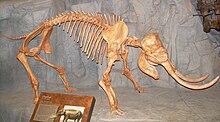
Dwarf elephants are prehistoric members of the order Proboscidea which, through the process of allopatric speciation on islands, evolved much smaller body sizes (around 1–2.3 metres (3 ft 3 in – 7 ft 7 in) shoulder height) in comparison with their immediate ancestors. Dwarf elephants are an example of insular dwarfism, the phenomenon whereby large terrestrial vertebrates (usually mammals) that colonize islands evolve dwarf forms, a phenomenon attributed to adaptation to resource-poor environments and lack of predation and competition.
Fossil remains of dwarf elephants have been found on the Mediterranean islands of Cyprus, Malta, Crete, Sicily, Sardinia, the Cyclades Islands and the Dodecanese Islands, which are mostly members of the genus Palaeoloxodon, descending from the large 4 metres (13 ft) tall straight-tusked elephant (Palaeoloxodon antiquus) of mainland Europe, though two species represent dwarf mammoths. Dwarf species of elephants and Stegodon have been found on the islands of Indonesia and the Philippines, with dwarfed species of Stegodon also having been found in Japan. The Channel Islands of California once supported the pygmy mammoth, a dwarf species descended from Columbian mammoths,[1] while the woolly mammoths that existed on Wrangel Island north of Siberia were once considered dwarfs, but are not anymore.